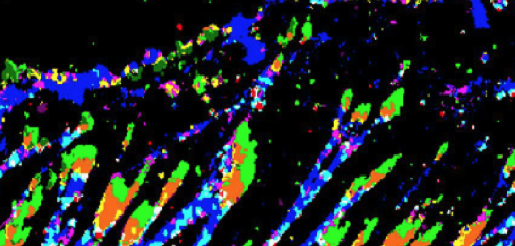
Caco-2 cells labeled for tight junction molecule cingulin (green), actin (red), vinculin (pink) and DNA (blue).

Epithelial cells growing on a patterned adhesive surface with the shape of the Weizmann Institute tree.

Desmosomes in mouse tongue epithelium (by transmission electron microscope).

Porcine aortic endothelial cell, double-labeled for actin (green) and phospho-tyrosine (red).

“Molecular composition map” of focal adhesions and stress fibers.

Myeloma cancer cell responding to shear flow (by scanning electron microscope).
You are here
Scientific Activities ››Adhesion of immune cells
Cell-cell and cell-matrix adhesions are known to play key roles in the recruitment and activation of immune T-cells. Prominent among the molecular adhesion components are integrins (β1 and β2), that mediate the interactions of a variety of immune cells to extracellular matrices, and to other immune cells, respectively. In our current attempts to create a synthetic “immune niche,” we employ diverse surface patterning approaches that might mimic “partnering cells”, which are regularly located in the immune niches, and replace them in the process of T-cell activation (Figure 1).

Figure 1
The complexity of the natural immune niches within lymph nodes. (a) Lymph node-residing and infiltrating T-cells and dendritic cells (DC) migrate on a 3D network of fibroblastic reticular cells (FRCs) and their associated ECM. (a1) T cells can also interact with, and be activated by, DCs presenting via MHC/HLA a specific antigen matching the T-cell receptor, and accompanied by co-stimulatory (CD80/CD86 DCs, and CD28 T cells) and adhesive molecules (ICAM-1/LFA-3 DCs, and LFA-1/CD2 T cells). (a2,3) Both DCs and T cells interact with FRCs and their secreted chemokines (CCL19, CCL21), as well as cytokines (IL-6, IL-7), which promote their migration and survival. (a4) Activated T-cells form intercellular contacts with each other and cluster through ICAM-1-LFA-1 binding. Secretion of IL-2 by activated T-cells induces an autocrine- and paracrine-induced proliferative effect on adjacent T-cells. (b) In a novel approach for construction of a synthetic immune niche, many of the cell-bound and ECM-associated ligands are transferred to a synthetic 2D (left) or 3D scaffold (right), to which T cells can bind. In the synthetic niche, interactions with the functionalized scaffold are expected to provide the signals needed for T-cell activation (with or without antigen specificity), lineage selection, proliferation, and survival.
In these studies, we tailor extracellular nanopatterns that can provide specific stimulation of cytokines, and reduce the rate of cell death. Furthermore, we aim at creating conditions that will enable us to develop an effective ex vivo stimulation system, tailored for different subclasses of T cells, including helper CD4+ cells, cytotoxic (CD8+) T cells, and T regulatory (T-Reg) cells.
Further Reading
Adutler-Lieber, S; Zaretsky, I; Platzman, I; Deeg, J; Friedman, N; Spatz, JP; Geiger, B (2014).
Engineering of synthetic cellular microenvironments: Implications for immunity.
Journal of Autoimmunity.
54
:100-111.


- Scientific Activities
- Nano-architecture of adhesion complexes
- Cell-adhesion sensing of the extracellular matrix
- Cancer adhesion and invasion
- Mechanosensitivity of integrin adhesions
- Cell biology of osteoclasts
- Adhesion-mediated signaling
- Platelet adhesion
- Quantitative automated microscopy for high-throughput screening
- Adhesion diversity and the integrin adhesome network
- Adhesion of immune cells
- Heart muscle development
- Publications
- Group Members
- Collaborations
- Screening Projects
- Software
- Galleries
- Research
